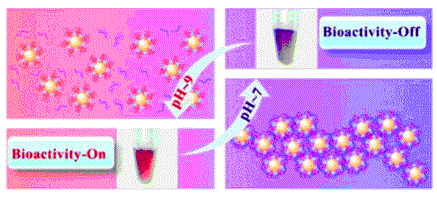Feng Liu,a Lulu Xue,a Yuqi Yuan,a Jingjing Pan,a Chenjie Zhang,a Hongwei Wang(王宏炜)*a, John L. Brash,b Lin Yuan(袁琳)*a and Hong Chena
a The Key Lab of Health Chemistry and Molecular Diagnosis of Suzhou, College of Chemistry, Chemical Engineering and Materials Science, Soochow University
b School of Biomedical Engineering, Department of Chemical Engineering, McMaster University, Hamilton, Canada
Nanoscale, 2016,8, 4387-4394
The modulation of protein activity is of significance for disease therapy, molecular diagnostics, and tissue engineering. Nanoparticles offer a new platform for the preparation of protein conjugates with improved protein properties. In the present work, Escherichia coli (E. coli) inorganic pyrophosphatase (PPase) and poly(methacrylic acid) (PMAA) were attached together to gold nanoparticles (AuNPs), forming AuNP–PPase–PMAA conjugates having controllable multi-biofunctionalities and responsiveness to pH. By treating with poly(2-(dimethylamino)ethyl methacrylate) (PDMAEMA) and regulating the pH, the bioactivity of the conjugate becomes “on/off”-switchable. In addition, by taking advantage of the ability of AuNPs to undergo reversible aggregation/dispersion, the conjugates can be recycled and reused multiple times; and due to the shielding effect of the PMAA, the conjugated enzyme has high resistance to protease digestion. This approach has considerable potential in areas such as controlled delivery and release of drugs, biosensing, and biocatalysis.

链接://pubs.rsc.org/en/content/articlelanding/2016/nr/c5nr07436c#!divAbstract